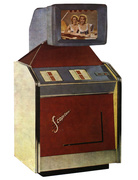
“Circuitry is technology. Without circuitry there are no computers. But I got into circuitry to get away from computers. It’s truly weird.” That’s circuit bender and music-effects-guru Drew Blanke, aka Dr. Blankenstein, on his love of the tiny devices that enable or inhibit the flow of electricity through a machine. For him, electricity is not a means to an end, the passive power that allows you to watch every episode of “Adventure Time” or code on your laptop until dawn. No, for Blanke, electricity, along with the wires and circuits that carry it, is the instrument itself.
“You can use the same hardware to knock an elephant on its butt or write techno.”
Blanke has been playing instruments of one form or another for most of his 35 years. As a teenager, he jammed in New York City clubs and bars. In college, he studied audio engineering, but also jazz composition. And when he was in his 20s, while running a marketing company that he has since sold, he played a lot of electronic music, often performing at private parties and events such as the Stony Awards for High Times magazine. “My love for blinking lights and knobs and sliders started really young.”
During the past few years, Blanke has merged his love of music and electricity into a small business, which lets him use both his marketing and soldering skills to produce graphically intense little boxes, adorned with switches and knobs users can control, light and touch sensors users can interact with, and LEDs to give them pinpointed feedback about what’s going on inside. Blanke’s creations are heavily influenced by electronic-music pioneers Léon Theremin, whose eponymous instrument generates sounds based on the proximity of a musician’s hands to a pair of antennae, and Robert Moog, the father of the electronic music synthesizer.

Above: Dr. Blankenstein with Squarepusher, holding the Sonic Crusher that Blanke made just for him. Top: A sneak peak at version 2.5 of Blanke’s Atari Punk Console.
In fact, Blanke is an unabashed fanboy when it comes to circuits, the visionaries who turned them into instruments, and the musicians who manipulate them, going so far as to make one-off effects boxes for some of his current musical heroes.
For techno musician Tom Jenkinson, aka Squarepusher, Blanke made the Sonic Crusher, which he describes as a “vocal processor, audio scrambler, robot box.” He personally delivered the distortion device to Squarepusher at MoogFest 2012 in Asheville, North Carolina. More recently, in the spring of 2013, Blanke loitered like a groupie outside the stage door of the Brooks Atkinson Theatre after attending a performance of the Broadway musical “Hands on a Hardbody.” His goal? To give a one-of-a-kind version of an effects box he calls the Illumiringer to Trey Anastasio of the jam band Phish, who composed much of the music for “Hardbody” and whose playing style inspired many of the Illumiringer’s coolest features. When presented with the heartfelt gift, Anastasio was all smiles.
Not bad for a guy who got his start taking apart a Tomy Verbox RX 5401 robot he received for his seventh birthday in the mid-1980s from his Grandpa Toby. “It responded to voice commands with movements, blinking lights, and sounds,” Blanke remembers. “The problem was, it didn’t work very well. I suppose I opened it up to see if I could figure out how it was listening to my voice. I’m not sure what I hoped to accomplish (maybe I expected to see a little man in there with a crank, or something), but I remember the thrill of finally getting it open, and then wondering how I was going to put it back together again. That never happened; I broke all my toys.”
Around the same time, the precocious preteen, whose favorite TV show was “Mr. Wizard’s World” on Nickelodeon, was getting into Heathkits, the 20th-century’s premier manufacturer of do-it-yourself home-electronics and electronics-testing kits. “The first Heathkit I put together by myself was a rather simple, 100-component, AM transistor radio. But even before that, I built a Heathkit programmable music doorbell with my father. That was very cool. It was like a module sequencer, letting you change the melody by pulling and pushing wires into the board at different places. I actually have that kit on my workbench as we speak.”

The first Moog synthesizer, commissioned by the Alwin Nikolai Dance Theater of New York in 1964. The machine is now part of the Stearns Collection, University of Michigan.
Looking back on those formative years, Blanke realizes he almost missed the Heathkit party. “Unfortunately, 1986 was a really bad time to get into Heathkit because they went out of business a few years after that.” Blanke was not even alive during the formative years of Moog in the mid-1950s, when Bob Moog made his fledgling company’s first Theremin kits, or even during its heyday in the late 1960s, when the Moog movement exploded a few years after the first Moog synthesizer prototype was unveiled in 1964.
In fact, by the time Blanke was dismantling toy robots and falling in love with analog circuitry in the mid-to-late 1980s, digital devices were poised to dominate consumer electronics and the musical-instruments world. Eventually, they won, forcing mighty Moog itself to scramble to prevent its once-cutting-edge brand from becoming a synonym for “electronic dinosaur.”
Today, thanks to digital technology that uses software as well as hardware to produce music, musicians can make just about any sound they want on a basic iPad. This has led to a kind of democratization of sound, which most observers applaud, but digital-musical devices have also turned sound into just another commodity to be exploited and spat out by anyone who can get their mitts on it. Obviously the ability to produce any sound cheaply and on command is convenient, but when sound ceases to be special it often ceases to delight, becoming a mere means to a soulless, predictable end.

In 2013, Blanke presented Trey Anastasio of Phish with an Illumiringer he designed for the guitarist.
That’s where Blanke and others like him come in, providing musicians with more than just cool tools that ape or contort sound. Instead, Blanke is building an entirely new line of experimental, electronic instruments, which he assembles by hand in his Manhattan apartment, like a luthier crafting a fine guitar (only with lots more soldering).
The effects produced by Blanke’s instruments vary wildly, but the basic principle behind them and any other analog electronic instrument is essentially the same.

Like many of Blanke’s electronic instruments, the one Blanke designed for Trey Anastasio features a light sensor to produce Theremin-like effects.
To put it as simply as possible, an electrical current wants to move. For example, when you plug a vacuum cleaner into a wall receptacle, the current immediately flows into it. The vacuum cleaner would turn on instantly if a switch did not interrupt the current. When that switch is flipped, the vacuum cleaner starts up and you can get on with your housekeeping.
Similarly, in Blanke’s devices such as the Atari Punk Console, users can stomp on buttons, turn knobs, and use light like a poor-man’s Theremin to control the flow of electricity into an analog chip, which is simply a collection of tiny circuits packed together like so many angels on the head of a pin. The chip acts as an oscillator, which in turn regulates the amount of voltage flowing through the device and out to a speaker, so you can hear what all that oscillating voltage actually sounds like.
Weirdly, the analog chip in Blanke’s Atari Punk Console is the same as the one used in stun guns. “It’s the same basic elements mixed around in a different order,” he says of the differences between his instrument and the weapon. “You can use the same hardware to knock an elephant on its butt or write techno. That’s really liberating.”

Blanke’s Illumiringer wiring and its chip (at top) can be installed into a guitar. The author installed a similar “mod kit” in his Danelectro.
The Illumiringer runs on a different chip (in this case, the same chip that was once used as a tone decoder in telephones) and gives a musician even more controls over the signal passing through it, via a light sensor, several touch points, potentiometers (most people know these common pieces of hardware as “knobs”), and expression pedals, all of which allow the user to vary the resistance of electricity flowing into different parts of the chip and then out again.
Unlike a digital instrument, whose output can be preset for a musician so he or she doesn’t have to think too much about achieving a particular sound, the output on one of Blanke’s analog instruments, especially those with physical touch points and light sensors like the Illumiringer, can be tricky to control.
I learned just how tricky when Blanke challenged me to take a drill to the body of my beloved yellow Danelectro guitar and fill its guts with some of his Illumiringer hardware.
Now my Danelectro, however beloved, is by no means a rare or valuable instrument. It was made sometime in the 1990s, cost me less than 200 bucks, and has survived the abuse of two male high-school students (our children, now full grown) and their friends. But when Drew Blanke enthusiastically told me how cool it would be to drill eight holes in my guitar, the Danelectro instantly became my baby, and the prospect of chickening out and just plugging the thing into an iPad started to sound pretty good. When an envelope stuffed with a light sensor, a pair of LEDs, no less than five switches and knobs, and a rat’s nest of wire connected to a sinister-looking circuit board arrived, I became downright alarmed.
“It’s half-built,” Blanke said, trying to reassure me about how easy it would be to install his “FX mod kit,” as he calls it. “The installation is literally six solder points. It’s like a gateway drug to circuitry. In essence, all you’re doing is installing a guitar pedal inside of your guitar.”
During the month of procrastination that followed, Blanke sent me encouraging emails. “You’re the only person out there so far who has the wet-dry mix-knob configuration,” he’d crow, which only made me more nervous. “It goes nuts with strobe lights,” he continued. “If you have a light on a dimmer, you could put it in light-sensor mode, hit a note on the guitar, and raise the dimmer until you hear those self-harmonic frequencies get in pitch with the guitar. Now you can do pitch bends because you’re in key with the effect, and any slight movement you make with your body will bring you down a half step. It’s not going to sound like any other effect out there.”
All right, already! Finally, one Saturday, I took the strings off my guitar and removed the neck to make it easier to work on, and then began to mark out the spots where I would drill. I measured once, twice, three times, and more, to make sure the holes I was about to drill in the face of my guitar were going to correspond to the access port in the back. Just to be safe, I checked my measurements a couple dozen more times before finally drilling that first hole.
“My love for blinking lights and knobs and sliders started really young.”
After that, I couldn’t stop. Frankly, it was fun to drill holes in a perfectly good instrument. In the end, I lined up the three potentiometers, which regulate effect’s volume, the effect itself, and the effect’s tone (from “wet” to “dry”), in a reasonably neat row just above the guitar’s existing pickup controls. At Blanke’s suggestion, I put the toggle switch between the yellow and green LEDs to indicate whether the guitar is in sensor mode (yellow) or knob mode (green). And I placed the on-off switch for the mod itself as far away from the action as possible.
That left the sensor, which I had wanted to put under the strings as Blanke had done in one of his online demos. Unfortunately I could not get to that part of the guitar from the instrument’s access port, so I just stuck it in the only place that was left where it would fit. As blind luck would have it, it turned out to be a good spot, better, I think, than under the strings.

Blanke has given his Illumiringers numerous graphic treatments. This one is the Star Wars edition.
With the help a friend who is an ace with a soldering gun, the connections were eventually made, I put everything back together, and much to my complete surprise, it worked. You can still play the instrument like any other electric guitar, but if you flip the on-off switch, all of a sudden you are in Illumiringer-land, which you can navigate via a knob (indicated by the green LED) or a light sensor (indicated by the yellow). Now I find myself noodling otherworldly sounds late at night, no doubt to the mystification, and chagrin, of our next-door neighbor.
“Analog circuitry,” says Blanke of the stuff inside my Danelectro, “is probably truer to a guitar than picking up a Raspberry Pi and writing a distortion algorithm on a computer.” I’m not sure what that would entail, and I don’t think most people would describe many of the sounds coming out of my guitar as music (when the volume knob is opened up all the way up and the wet-dry knob is turned as far as it will go to “wet,” I’m certain music is not the right word). But I can definitely see how someone could take the sounds I’m stumbling upon and weave them into something else that a lot of people might dance to.

Blanke’s workbench in his Manhattan apartment. Note the Heathkit doorbell unit in the foreground at right, the same one he made with his dad when he was a kid.

 Scopitone: '60s Music Videos You've Never Seen
Scopitone: '60s Music Videos You've Never Seen
 The Otherworldly Sounds of the Clavioline, From Musical Saw to Wailing Cat
The Otherworldly Sounds of the Clavioline, From Musical Saw to Wailing Cat Scopitone: '60s Music Videos You've Never Seen
Scopitone: '60s Music Videos You've Never Seen God Save the Eight-Track
God Save the Eight-Track Guitar Effects PedalsIn the 1960s, electric-guitar players were looking for something more than …
Guitar Effects PedalsIn the 1960s, electric-guitar players were looking for something more than … Keyboards and SynthesizersKeyboards and synthesizers are instruments that electronically replicate th…
Keyboards and SynthesizersKeyboards and synthesizers are instruments that electronically replicate th… Mari Tepper: Laying it on the Line
Mari Tepper: Laying it on the Line Nice Ice: Valerie Hammond on the Genteel Charm of Vintage Canadian Costume Jewelry
Nice Ice: Valerie Hammond on the Genteel Charm of Vintage Canadian Costume Jewelry How Jim Heimann Got Crazy for California Architecture
How Jim Heimann Got Crazy for California Architecture Modernist Man: Jock Peters May Be the Most Influential Architect You've Never Heard Of
Modernist Man: Jock Peters May Be the Most Influential Architect You've Never Heard Of Meet Cute: Were Kokeshi Dolls the Models for Hello Kitty, Pokemon, and Be@rbrick?
Meet Cute: Were Kokeshi Dolls the Models for Hello Kitty, Pokemon, and Be@rbrick? When the King of Comedy Posters Set His Surreal Sights on the World of Rock 'n' Roll
When the King of Comedy Posters Set His Surreal Sights on the World of Rock 'n' Roll How One Artist Makes New Art From Old Coloring Books and Found Photos
How One Artist Makes New Art From Old Coloring Books and Found Photos Say Cheese! How Bad Photography Has Changed Our Definition of Good Pictures
Say Cheese! How Bad Photography Has Changed Our Definition of Good Pictures Middle Earthenware: One Family's Quest to Reclaim Its Place in British Pottery History
Middle Earthenware: One Family's Quest to Reclaim Its Place in British Pottery History Fancy Fowl: How an Evil Sea Captain and a Beloved Queen Made the World Crave KFC
Fancy Fowl: How an Evil Sea Captain and a Beloved Queen Made the World Crave KFC
Great peek into Blanke’s life, thank you. One quibble: So, it’s only music if you can dance to it? The 20th Century called, they want you to learn about what happened in music history.